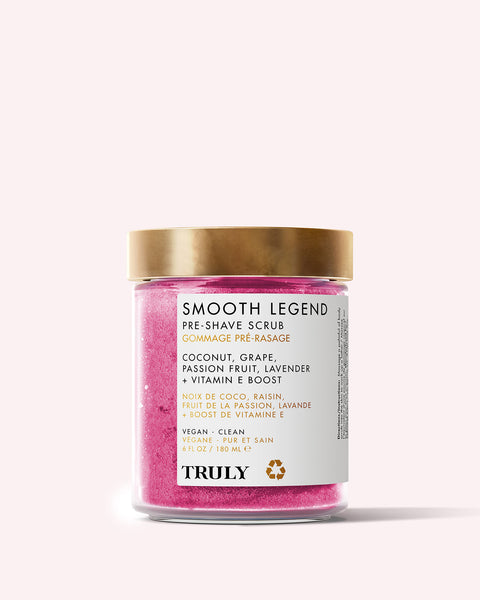How to Tell What Skin Type You Have

How to tell what skin type you have isn’t complicated. You just need to know the signs. Once you identify your skin type, you can make more informed decisions about your skincare routine. You’ll also be able to use products that tend better to your skin’s needs.
“What is my skin type?” is a commonly searched question. You’d think it would be easy but sometimes it can feel a little confusing. Perhaps you have oily patches in some areas and dryness in others. Or maybe your skin feels tight and dry but you still get blemishes.
Ahead, we’re going to show you how to tell what skin type you have and the best skincare routine (and products) for your skin type.
How to Tell What Skin Type You Have
Knowing your skin type can be a gamechanger in your skincare routine. Sometimes, it might even resolve current skin concerns with which you’re dealing, such as fine lines, pimples, and discoloration. There are five different skin types: dry, oily, combination, sensitive, and normal. Here are the different types of skin, and characteristics of each.
Dry Skin
Dry skin produces less sebum than other skin types and consequently, lacks moisture. It may feel rough or tight and appear dull and flaky, especially in colder months. Since sebum plays an essential role in moisturizing the skin, the lack of natural oils leads to dry, dull skin. It may even feel irritated.
Fine lines and wrinkles tend to appear more prominent in people with dry skin. This is usually because of the lack of oils and moisture, cell turnover slowing down, and increased vulnerability to pollution and UV damage.
According to dermatologists, there are several factors that can trigger dry skin. The main cause is a weak skin barrier. The skin barrier supports overall skin health. It helps retain water in the skin while protecting against external aggressors. So when the skin barrier is compromised, skin ends up feeling dry.
Signs:
• Dryness
• Flakiness
• Tightness
• Rough patches
• Dull appearance
Oily Skin
Oily skin is characterized by an overproduction of sebum, which can lead to a shiny appearance and enlarged pores. This skin type is often prone to acne, blackheads, and other blemishes due to excess oil and clogged pores. While the natural oils can help keep the skin hydrated, too much can create an imbalance that leads to breakouts.
People with oily skin might notice that their makeup doesn’t stay put for long or that their skin feels greasy throughout the day. It’s important to choose the right products to help control oil production without stripping the skin of its necessary moisture.
One easy way to check if you have oily skin is by using blotting paper. If after a few hours of cleansing, you notice the blotting sheet absorbs a lot of oil, especially in the T-zone, it’s a sign that you have oily skin.
Signs:
• Shiny appearance, especially in the T-zone (forehead, nose, chin)
• Enlarged pores
• Frequent breakouts and blemishes
• Makeup wears off quickly
Combination Skin
Combination skin is exactly what it sounds like: a mix of different skin types on different areas of the face. With combination skin, the T-zone may be oily, while the cheeks and other areas may be dry or normal. This can make it a bit tricky to find the right products, as what works for one area of your face may not work for another.
If you have the combination skin type, you might find yourself dealing with an oily forehead but dry patches around your cheeks or jawline. The key is to find a balance, using products that can address both concerns without exacerbating either condition.
Signs:
• Oily in some areas (usually T-zone)
• Dry or flaky patches in other areas
• Enlarged pores in oily areas
• Breakouts in oily parts of your face, with dryness in others
Sensitive Skin
Sensitive skin is often easily irritated and can react negatively to certain skincare products, weather changes, or stress. Those with sensitive skin may experience redness, itching, burning, or dryness. It’s crucial to be mindful of the ingredients in skincare products, as many can trigger reactions.
You’ll know you have sensitive skin if your skin gets inflamed easily. If new products like facial cleansers and serums tend to leave your skin red and irritated, it’s likely you have sensitive skin. That’s why it’s always best to choose gentle, fragrance-free products designed for your skin type.
Signs:
• Redness
• Itching
• Burning
• Dryness and tightness
• Reactions to skincare products (rash, hives, etc.)
Normal Skin
Normal skin is often seen as the ideal skin type because it’s well-balanced—not too oily, not too dry. People with normal skin typically have a smooth texture, even tone, and few visible pores. This skin type is less prone to breakouts or dryness, but it still requires regular care to maintain its health and balance.
While normal skin is often low-maintenance, it can still benefit from a consistent skincare routine to keep it looking its best.
Signs:
• Smooth texture
• No visible dry patches or excessive oil
• Small pores
• Rarely experiences breakouts or sensitivity
• Even skin tone
Skincare Routine for Each Skin Type
Now you know how to tell what skin type you have. Once you’ve identified your skin type, it’s time to build a skincare routine that works with, not against, your skin. Using the best products for your skin type will help you achieve healthy, glowing skin. Let’s break down the best routines and products for each skin type.
Dry Skin Routine
If you have dry skin, your goal is to restore and lock in moisture. Hydration is key, so choose products with humectants and emollients which draw and seal in moisture, like hyaluronic acid, jojoba oil, and shea butter.
Here’s an easy routine for dry skin types.
Step 1. Hydrating Cleanser: Avoid harsh cleansers that can dry out your skin further. Look for a cleansing balm or cream infused with hydrating ingredients like jojoba oil, coconut oil, and hyaluronic acid.
Step 2. Moisturizing Serum: A serum containing vitamin E, coconut oil, hyaluronic acid, or glycerin will help restore the skin’s barrier and keep skin hydrated.
Step 3. Rich Moisturizer: Look for a thick, rich moisturizer with ingredients like shea butter or vitamin E to help promote hydrated, healthy skin that feels soft and supple.
Step 4. Sunscreen: Opt for a hydrating sunscreen with SPF 30 or higher to protect your skin from UV damage.
Oily Skin Routine
Oily skin requires balancing oil production without stripping the skin’s natural moisture. It’s essential to use lightweight, oil-controlling products that won’t clog your pores.
Here’s an easy routine for oily skin types.
Step 1. Foaming Cleanser: Choose a salicylic acid-based cleanser to help control excess oil, remove impurities, and prevent breakouts.
Step 2. Oil-free Toner: A toner with witch hazel or tea tree oil can help reduce shine.
Step 3. Lightweight Serum: A serum with retinol helps boost skin cell turnover and regulate oil production for clearer, more matte looking skin.
Step 4. Moisturizer: Follow up with a lightweight moisturizer.
Step 5. Oil-free Sunscreen: A matte-finish sunscreen will control shine throughout the day while protecting you against premature skin aging.
Combination Skin Routine
For combination skin, balance is everything. You want to target oil control in the T-zone while keeping other areas hydrated.
Here’s an easy routine for combination skin types.
Step 1. Cleansing Balm: Use a gentle cleansing balm to remove dirt and oil without drying out your skin.
Step 2. Niacinamide Serum: Apply a lightweight, hydrating serum with niacinamide to smooth the skin and refine pores.
Step 3. Moisturizer: Use a lighter moisturizer on oily areas and a richer cream on dry areas.
Step 4. Sunscreen: A non-greasy, broad-spectrum sunscreen will protect your skin without adding excess oil.
Sensitive Skin Routine
Sensitive skin needs extra care to avoid irritation. The secret is to use gentle, soothing products that protect your skin barrier.
Here’s an easy routine for sensitive skin types.
Step 1. Cleansing Balm: Choose a fragrance-free, hydrating cleanser that won’t strip your skin.
Step 2. Calming Serum: Look for serums with soothing ingredients like jojoba oil, niacinamide, and aloe vera.
Step 3. Fragrance-free Moisturizer: A rich, fragrance-free moisturizer will hydrate without irritating.
Step 4. Mineral Sunscreen: Use a mineral sunscreen with zinc oxide or titanium dioxide, which is less likely to cause a reaction.
Normal Skin Routine
Normal skin may not have major concerns, but a consistent routine will keep your skin looking its best. Choose a routine that best targets any issues you may have, like fine lines or hyperpigmentation.
Here’s an easy preventative routine for normal skin types.
Step 1. Gentle Cleanser: Use a mild cleanser to keep your skin clean and balanced.
Step 2. Vitamin C Serum: Apply a brightening serum with vitamin C to keep your complexion radiant and retinol to prevent signs of aging.
Step 3. Moisturizer: A lightweight moisturizer will keep your skin hydrated without feeling heavy.
Step 4. Sunscreen: Use a broad-spectrum sunscreen with SPF 30 or above to protect your skin from UV damage.
What is My Skin Type Quiz?
How to tell what skin type you have? To make it even easier to identify your skin type, we’ve created a simple quiz that you can take right now. Answer the questions below and once you’re done, you’ll find your skin type at the end.
1. How does your skin feel after cleansing?
A) Tight and dry
B) Oily and shiny
C) Some areas dry, others oily
D) It feels comfortable and balanced
E) Irritated or sensitive
2. How often do you experience breakouts?
A) Rarely or never
B) Often
C) Occasionally, usually in my T-zone
D) Sometimes, but not frequently
E) Frequently, and they can be painful
3. How does your skin react to changes in weather?
A) It gets drier and more sensitive
B) It stays the same or gets oilier
C) Some areas get dry while others become oily
D) It generally stays the same
E) It reacts with redness or irritation
4. What’s your main skin concern?
A) Dryness and flaking
B) Oiliness and shine
C) Combination of oiliness and dryness
D) Maintaining balance and hydration
E) Sensitivity and redness
5. How would you describe the overall texture of your skin?
A) Rough or flaky
B) Smooth but oily
C) A mix of smooth and uneven
D) Smooth and even
E) Sensitive or prone to bumps
Your Skin Type is...
Now, tally your answers based on the letters you selected.
Mostly A’s: Dry Skin
Your skin produces less sebum, leading to dryness and potential irritation. Focus on hydrating and nourishing products to restore moisture.
Mostly B’s: Oily Skin
Your skin produces excess oil, making you prone to breakouts. Look for oil-free and non-comedogenic products to keep your skin balanced.
Mostly C’s: Combination Skin
Your skin has both dry and oily areas. Use a tailored approach, selecting products that address the needs of both skin types.
Mostly D’s: Normal Skin
You have a balanced complexion! Maintain this harmony with a simple routine that includes hydration and sun protection.
Mostly E’s: Sensitive Skin
Your skin reacts easily to products and environmental factors. Choose gentle, fragrance-free products designed for sensitive skin.
Now you know how to tell what skin type you have and you’ve purchased your recommended routine, take the Truly Quiz to get matched with your dream body care routine.












